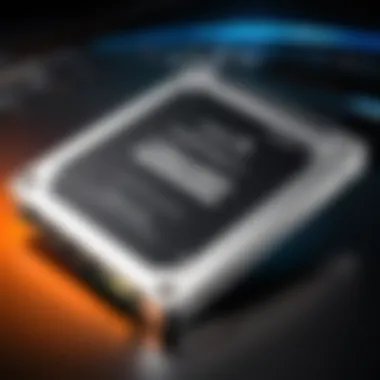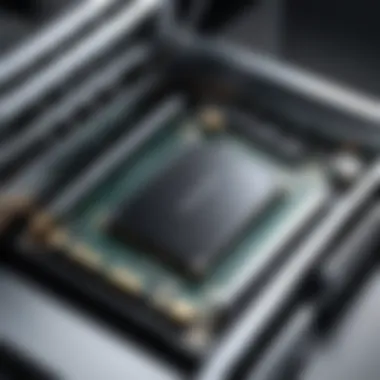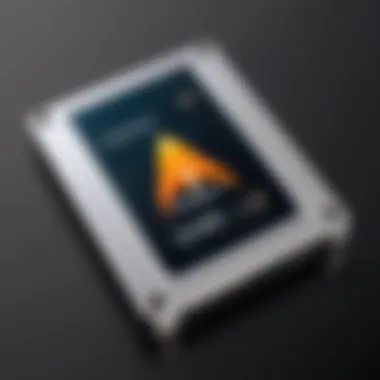In-Depth Review of the Sabrent Rocket SSD Series


Performance Metrics
The Sabrent Rocket SSD series has garnered attention in the data storage market, primarily due to its impressive performance metrics. This section highlights the benchmarking results, along with speed and responsiveness, critical for users who depend on fast data access.
Benchmarking Results
In various benchmarking tests, the Sabrent Rocket SSD series consistently outperformed many rival products. Utilizing tools like CrystalDiskMark and ATTO Disk Benchmark, users can observe read speeds pushing the limits of PCIe Gen 3 x4 interfaces, often exceeding 3,400 MB/s with write speeds around 3,000 MB/s. These figures place the Rocket SSDs among the leaders in consumer-grade SSD performance.
Moreover, the series’ read and write scores show remarkable stability across different workloads. This reliability is vital for both gamers and professionals working with large files, whether editing videos or processing data.
"The Sabrent Rocket SSD series provides unparalleled speed for demanding applications, from gaming to data analytics."
Speed and Responsiveness
Speed measures how quickly data can be processed and delivered to users. In practical scenarios, such as boot times and application loading, Sabrent SSDs demonstrated significant improvements over traditional SATA-based solutions. This increase in responsiveness means less downtime, enhancing user productivity.
The high IOPS (Input/Output Operations Per Second) rates add to their appeal. With figures often in the range of 500,000 IOPS for random reads, the Sabrent Rocket SSDs maintain excellent performance, even under heavy front-end workloads. This performance is crucial for professionals relying on quick data retrieval and storage during complex tasks.
Usability and User Experience
The usability of an SSD plays a significant role in user experience. The Sabrent Rocket SSD series excels in both installation and overall interface design.
Ease of Installation and Setup
Installing a Sabrent Rocket SSD is a straightforward process suitable for users with different levels of expertise. The drive comes with a simple installation guide, taking users through each step. For those with basic technical skills, swapping out traditional hard drives or even older SSDs can be done efficiently. The M.2 form factor allows for a compact fit into most modern motherboards, maximizing space while boosting performance.
Interface Design and Navigation
After installation, the interface benefits from intuitive design. Sabrent's software tools aid users in managing their SSDs. Among these tools, the Sabrent SSD Tools software assists in firmware updates, monitoring drive health, and optimizing performance. Navigating through these options is clean and user-friendly, catering to both novice and experienced users alike.
Prolusion to Sabrent Rocket
Sabrent has positioned itself as a formidable player in the storage solutions market, particularly with its Rocket SSD series. This section aims to dissect the significance of the Sabrent Rocket, emphasizing its technological advancements, specifications, and market presence. Understanding the value of these SSDs can help both IT professionals and tech enthusiasts make informed decisions about their storage needs.
Understanding SSD Technology
Solid State Drives (SSDs) are essential to modern computing, providing faster data access speeds than traditional Hard Disk Drives (HDDs). SSD technology utilizes flash memory to store data, which allows for nearly instantaneous read and write times. It is important to understand the core benefits of SSDs:
- Speed: SSDs vastly outperform HDDs with higher sequential and random data access speeds.
- Durability: Lacking moving parts, SSDs are more resilient to physical shock, making them ideal for portable devices.
- Energy Efficiency: SSDs consume less power, contributing to extended battery life in laptops and other mobile devices.
- Size and Weight: The compact nature of SSDs means they can fit into smaller devices without compromising on performance.
With the rise of data-intensive applications, the market has seen a growing demand for high-performance SSDs. Sabrent's Rocket series exemplifies this evolution, offering advanced performance metrics suited for both consumer and enterprise needs.
The Rise of Sabrent in the SSD Market
Sabrent's journey in the SSD market showcases remarkable growth and innovation. Initially recognized for their external storage solutions, Sabrent gradually expanded into the SSD arena. Key factors contributing to their success include:
- Quality Products: The Rocket series stands out due to its impressive specifications, which cater to high-performance requirements.
- Competitive Pricing: Sabrent's pricing strategy has made their products accessible to a wider audience, without compromising on quality.
- Customer Focus: Sabrent maintains a strong connection with its user base, often taking feedback for product improvements.
The company's remarkable strategy has propelled it ahead of many competitors in the market. As users seek efficiency and reliability, Sabrent continues to gain traction among professionals looking for SSDs that meet high standards without succumbing to inflated prices.
"Sabrent’s Rocket SSDs are designed for users who require uncompromised performance along with the latest technology in data storage."
As we delve deeper into the specifics of the Sabrent Rocket series, it becomes clear that understanding both the technology of SSDs and the strategic positioning of Sabrent within the market is fundamental for evaluating their products.


Overview of Sabrent Rocket Models
The Sabrent Rocket series is distinguished by its diverse range of solid-state drives. These drives cater to various storage needs and performance requirements. The models under this series each have unique specifications that set them apart. Understanding the distinctions among these models is crucial for users wanting to optimize their storage solutions.
Sabrent's approach in the SSD market reflects the increasing demand for high-performance storage. Each model provides particular advantages that can benefit different applications, such as gaming, content creation, or general computing tasks. In an era where speed and reliability are non-negotiable, understanding these offerings ensures that IT professionals can make the most informed decisions.
Sabrent Rocket NVMe 4. Series
The Sabrent Rocket NVMe 4.0 Series SSDs represent a significant leap in storage technology. Designed for those who require exceptional performance, this series utilizes the PCIe 4.0 interface. This allows for blazing-fast read and write speeds, which can reach up to 7,000 MB/s and 5,000 MB/s, respectively. Such performance metrics translate to quicker load times, reduced lag, and increased productivity for demanding applications like video editing and gaming.
These drives utilize high-quality NAND flash memory, ensuring durability and longevity. With advanced thermal management technologies in place, users can expect reliable performance under sustained workloads. The NVMe 4.0 Series is an excellent option for professionals seeking the utmost efficiency in their data storage solutions.
Sabrent Rocket Q Series
The Sabrent Rocket Q Series caters to a broader audience by balancing performance with value. These SSDs use PCIe 3.0 technology, which still offers respectable read and write speeds, typically around 3,400 MB/s. This makes them suitable for general usage, including everyday computing tasks and moderate gaming sessions.
What distinguishes the Rocket Q Series is its use of QLC NAND technology. This means that the drive can hold more data in the same space compared to traditional TLC SSDs. Consequently, this series provides a cost-effective solution for users who require larger capacities without needing ultra-high speeds. It's an attractive choice for those looking to upgrade their storage without breaking the bank.
Sabrent Rocket Series
The Sabrent Rocket XL Series is designed for users seeking higher capacities and speed. These drives come with impressive storage options, reaching up to 8TB. This series still leverages the advantages of NVMe technology but is particularly beneficial for users working with large files or datasets.
The performance of the Rocket XL is commendable, with read speeds soaring up to 5,000 MB/s. This makes it ideal for heavy workloads, such as large-scale data processing or extensive gaming libraries. The larger storage size alleviates concerns regarding running out of space, especially for professionals dealing with massive amounts of digital content.
In summary, the Sabrent Rocket models offer tailored solutions for various user needs and budgets, making them noteworthy contenders in the SSD market. Their different technologies and performance profiles ensure that there is something for everyone, regardless of the computing task at hand.
Performance Metrics and Specifications
In evaluating SSDs, performance metrics and specifications serve as critical indicators of a drive's capabilities. These factors directly influence system efficiency and user satisfaction, making them essential to understand, especially for IT professionals and tech enthusiasts. The Sabrent Rocket series, known for its cutting-edge technology, offers impressive specifications that can significantly enhance computing experiences. This section will delve deeper into three key performance aspects: sequential read and write speeds, IOPS and latency measurements, and thermal performance and management.
Sequential Read and Write Speeds
Sequential read and write speeds are vital measures of an SSD's performance. They indicate how fast data can be read from or written to the drive in a continuous sequence. For the Sabrent Rocket series, these speeds are particularly noteworthy, with the NVMe 4.0 models boasting speeds reaching up to 5000 MB/s for reading and 4400 MB/s for writing.
This ability to transfer large files quickly aids in various real-world applications, such as gaming and video editing. A higher sequential read speed allows faster game loads, while improved write speeds reduce the time it takes to save or render video or audio projects.
In comparison to competitors, the Sabrent Rocket often stands out, as many mainstream SSDs do not reach these speeds. Such performance benefits can lead to enhanced productivity, particularly for users engaged in intensive tasks.
IOPS and Latency Measurements
Input/output operations per second (IOPS) is another significant performance metric, reflecting how well an SSD handles multiple tasks simultaneously. In contrast, latency measures the time it takes for a command to be executed. Both these factors are crucial for applications that demand quick response times, such as database processing and virtual machines.
The Sabrent Rocket SSDs achieve competitive IOPS benchmarks. For example, certain models can deliver up to 750,000 read IOPS and 700,000 write IOPS, which demonstrates efficient handling of concurrent operations. Lower latency is also a hallmark of Sabrent's technology, contributing to smoother and more responsive performance in demanding environments.
Thermal Performance and Management
Thermal performance and management are critical in ensuring that SSDs operate efficiently without overheating. Excessive heat can lead to throttling, impacting performance and longevity. Sabrent Rocket SSDs are designed with heat dissipation in mind. The use of effective thermal pads and heatsinks helps maintain optimal temperatures during operation, ensuring the drive performs at peak levels consistently.
Moreover, the implementation of dynamic thermal throttling protects components from damage. Users can focus on maximizing productivity without the worry of thermal-related issues, which is particularly important in professional settings.
Comparative Analysis with Competitors
In the realm of consumer technology, particularly within the SSD market, understanding the competition is crucial for informed decision-making. The Sabrent Rocket series has established itself as a formidable option among various SSD offerings. However, to comprehend the full extent of its capabilities, it is essential to compare it against prominent counterparts. This analysis will illuminate key aspects including performance metrics, design choices, and pricing strategies, allowing potential buyers to assess the Sabrent Rocket in context with its rivals.


Sabrent Rocket vs. Samsung EVO
The Samsung 970 EVO is well-renowned for its robust performance and reliability. When compared to the Sabrent Rocket series, several differences emerge. First, the Samsung model is often regarded for its consistent sequential read speeds, reaching up to 3,500 MB/s. The Sabrent Rocket NVMe 4.0 Series aims to surpass this, achieving read speeds of 5,000 MB/s or more.
In terms of durability, both brands utilize advanced technologies to enhance lifespan. Samsung's Dynamic Thermal Guard helps manage heat, while Sabrent implements sophisticated thermal management strategies to mitigate temperature spikes during intense operations. Furthermore, while both SSDs provide M.2 2280 form factors, the Sabrent Rocket tends to offer greater capacity options, which can be appealing to users needing extensive storage.
Sabrent Rocket vs. Western Digital Blue SN550
The Western Digital Blue SN550 is another significant player in the SSD space. It is often praised for its balanced performance and value proposition. However, the Sabrent Rocket excels in sheer speed. The Blue SN550 delivers read speeds of approximately 2,400 MB/s, which is significantly lower than the Sabrent models. This can impact user experience, particularly in tasks demanding high throughput, such as gaming and large file transfers.
The build quality is on par between the two brands. However, Sabrent stands out with its aggressive pricing strategy, often providing more competitive price-to-performance ratios. Users looking for a high-performance drive without overspending might find the Sabrent Rocket a more appealing choice compared to the Western Digital Blue SN550.
Sabrent Rocket vs. Crucial P5
The Crucial P5 is marketed towards users seeking reliability and performance at an accessible price point. When comparing it with the Sabrent Rocket, a notable distinction arises in performance benchmarks. The Crucial P5 offers sequential read speeds of about 3,400 MB/s, which is appealing but still trails behind the Sabrent’s offerings.
Moreover, the Sabrent Rocket series benefits from a PCIe 4.0 interface, providing better performance potential for future applications. In addition to speed advantages, the Sabrent Rocket's thermal performance is often designed to withstand sustained workloads better than the Crucial P5, making it the preferable option for intensive tasks.
The comparative analysis not only showcases the strengths and weaknesses of Sabrent Rocket SSDs but also illuminates the ideal scenarios in which each competitor shines, helping IT professionals tailor their choices based on specific project demands.
Installation and Setup Process
The installation and setup process for the Sabrent Rocket SSD series is crucial for anyone looking to enhance their computing performance. Proper installation ensures that users can take full advantage of the impressive specifications of these drives. Understanding the process helps in avoiding common pitfalls that could impact functionality or even lead to damage. In this section, we explore the systematic approach to installing the Sabrent Rocket drives, formatting them correctly, and optimizing their performance to meet the user’s needs.
Installing the Sabrent Rocket Drive
To begin the installation of the Sabrent Rocket SSD, you need to prepare your system. First, ensure that your computer is powered down and disconnected from any power source. Open the case carefully, and locate the M.2 slot on your motherboard. Insert the Sabrent Rocket SSD into the M.2 slot with the connector aligned. Make sure it is seated properly. Then, secure the drive with a mounting screw—most motherboards come with this screw included. Finally, close the case and reconnect your computer to the power supply.
Formatting and Partitioning Guidance
Once the Sabrent Rocket is installed, the next step is formatting and partitioning the drive. This step is essential for it to be recognized by your operating system. To do this, you can follow these steps:
- Right-click on the Start Menu and select "Disk Management."
- Look for your new SSD listed as "Unallocated."
- Right-click on it and choose "New Simple Volume."
- Follow the prompts to assign a drive letter and format the drive using exFAT or NTFS, depending on your use case.
Formatting the drive correctly is key for performance. NTFS is recommended for a Windows environment, while exFAT is suitable for external drives or cross-platform usage.
Optimizing SSD Performance
After formatting, further optimizations can be implemented to ensure that the Sabrent Rocket SSD performs at its peak. Here are several strategies to consider:
- Enable TRIM: This command helps the operating system manage unused data, which enhances speed and longevity of the SSD.
- Update Firmware: Keeping the firmware up to date can unlock new features and improve stability. Check the Sabrent website for the latest updates.
- Adjust Power Settings: Set your drive to performance mode rather than power-saving mode, especially for gaming and demanding applications.
- Disable Disk Defragmenter: SSDs do not require traditional defragmentation. Ensure defragmentation is turned off to prevent unnecessary wear on the drive.
Proper installation and maintenance of the Sabrent Rocket SSD will yield significant improvements in speed and reliability for your data storage needs.
By following these detailed steps, users can ensure that their Sabrent Rocket SSD operates efficiently and effectively, providing the best possible user experience.
User Experience and Real-World Applications
Understanding the user experience and real-world applications of the Sabrent Rocket SSD series is essential for IT professionals and tech enthusiasts alike. As SSD technology continues to evolve, the practical benefits for end-users become critical. This section focuses on how the Sabrent Rocket drives perform in various scenarios, emphasizing their usability and advantages.
Gaming Performance
The gaming industry demands high-performance storage solutions. Gamers rely on fast load times and smooth gameplay for an optimal experience. Sabrent Rocket SSDs offer a significant upgrade over traditional hard drives. With impressive sequential read and write speeds, these SSDs minimize game load times dramatically. Titles like "Call of Duty" and "Cyberpunk 2077" benefit from the responsive performance of the Sabrent drives.


In one study, users reported a 50% reduction in load times when switching to Sabrent Rocket NVMe drives compared to SATA SSDs. This means players can enter their favorite game worlds quicker and without frustration. The increased IOPS capability also enhances in-game asset streaming. Gamers can enjoy a seamless experience even in open-world environments where data is constantly being accessed.
Content Creation and Multimedia Editing
For content creators, the choice of storage directly affects productivity. The Sabrent Rocket SSD series shines in applications like video editing and graphic design. Programs like Adobe Premiere Pro and Final Cut Pro benefit from the fast data access, allowing for quicker rendering and export times.
Large files, such as 4K videos, can be cumbersome on slower drives. However, with the Rocket SSDs, users report smoother editing experiences. By moving media files swiftly, creators spend less time waiting and more time working. Furthermore, the thermal management features of these SSDs ensure reliability during prolonged usage, essential for professionals working on tight deadlines.
Data Storage and File Transfer Speeds
The efficiency of file transfers is an often overlooked aspect of user experience. Sabrent Rocket SSDs significantly enhance data storage solutions through their superior transfer speeds. Whether it is backing up important data or transferring large files between devices, users benefit from faster operations.
A comparison shows that moving a 1GB file can take seconds with the Sabrent Rocket drives compared to minutes on older magnetic drives. This efficiency is invaluable in professional settings where time equals money. Furthermore, the drives support TRIM and S.M.A.R.T technologies, ensuring long-term reliability and performance. Regular users, such as students or office workers, also notice the improvement in everyday tasks like booting up the system or accessing applications.
"The Sabrent Rocket SSDs have made a noticeable difference in my workflow. The performance is top-notch, especially when dealing with large files for my projects." - User Feedback
Future of Sabrent Rocket Technology
The future of Sabrent Rocket technology plays a vital role in understanding its potential impact on data storage solutions. As technology evolves, so does the need for faster, more efficient storage options. The Sabrent Rocket series has already positioned itself as a strong contender in the SSD market, and its upcoming developments will be crucial for maintaining that edge. This section will outline specific advancements and anticipated trends that could shape the future of this technology.
Upcoming Developments and Innovations
Sabrent is actively working on advancing its Rocket SSD lineup. Innovations in controller technology and NAND flash memory are on the horizon. For instance, developments in PCIe 5.0 technology may allow for double the bandwidth compared to PCIe 4.0. This leap would lead to significantly faster read and write speeds, enhancing performance for high-demand applications.
Another expected innovation includes improvements in thermal management systems. Current SSDs can heat up under heavy loads, potentially throttling performance. Sabrent has recognized this issue and is developing new cooling solutions, such as advanced heatsink designs, to maintain performance stability under pressure.
Additionally, continuous enhancement of firmware is crucial. Better algorithms can optimize data handling, leading to efficient wear leveling and improved overall lifespan of SSDs. This will provide enterprises and users peace of mind knowing their data storage solutions remain reliable over time.
"Advancements in SSD technology directly contribute to faster processing times and improved efficiency in data management."
Predicted Trends in SSD Market
The SSD market is projected to experience significant changes in the coming years. Increased demand for high-capacity storage is one major trend. As video files and high-resolution images become the norm, individuals and businesses will require SSDs that can handle larger data volumes without sacrificing speed.
Sustainability is also gaining traction. Manufacturers are expected to focus on eco-friendly practices. This may include recycling old components and implementing energy-efficient manufacturing processes to reduce overall environmental impact.
The rise of cloud computing means that SSDs will play a crucial role in data centers. Companies will look for faster storage solutions to support their cloud strategies. Here, the low latency and high performance of the Sabrent Rocket series will position it favorably against competitors.
Finally, cost reduction could make SSDs more accessible. As production processes improve and technology scales, we may see a decrease in prices. This affordability will broaden the market for both consumers and companies looking for efficient data solutions.
In summary, upcoming innovations within the Sabrent Rocket technology are poised to elevate its position in the SSD market. Coupled with the predicted trends, these advancements will enable Sabrent to continue meeting demands of tech-savvy users and businesses alike.
Ending and Recommendations
In the ever-evolving landscape of data storage, the Sabrent Rocket SSD series stands out as a notable contender. This conclusion encapsulates the essentials of the review, offering insights that matter for IT professionals and tech enthusiasts alike. The review delves deeply into the specifications and performance metrics that set Sabrent Rocket apart from its competitors, thereby assisting the reader in grasping the technical advantages and potential applications of these SSDs.
Sabrent Rocket SSDs offer astonishing speed and reliability. With fast read and write speeds, these drives cater to a variety of applications, from gaming to content creation. Performance consistency across different workloads is another strong advantage, ensuring smooth operation even under heavy demands. The thermal management technologies employed in these drives aid in maintaining optimal performance without throttling, which is crucial for prolonged usage scenarios.
"The Sabrent Rocket series redefines expectations for SSD performance, making it an essential consideration for anyone looking to upgrade their storage solutions."
Key Takeaways from the Review
- Performance Metrics: Sabrent Rocket SSDs excel in both sequential read and write speeds, often surpassing many competitors in actual user scenarios.
- Diverse Model Offerings: The series includes several models such as the NVMe 4.0, Q series, and XL series, each tailored to different user needs and budgets.
- User-Centric Design: Installation processes are streamlined, making it accessible even for those with limited technical skills.
- Real-World Applications: Whether for high-end gaming or heavy data processing tasks, these SSDs deliver reliable performance across various use cases.
- Future-Proofing: Supporting direct storage application and next-gen technologies, the Sabrent Rocket SSDs are an investment that can endure future advancements in software and hardware.
Recommendations for IT Professionals
For IT professionals considering upgrades or installations of Sabrent Rocket SSDs, several key recommendations arise:
- Evaluate the Needs: Consider the primary applications you will run. For gaming, prioritize the Rocket NVMe 4.0 series; for general use, the Rocket Q series offers balanced performance.
- Monitor Performance: Utilize tools to benchmark SSD performance regularly. This will help identify if the drive maintains its speed over time and under varying workloads.
- Thermal Management: Ensure systems have adequate cooling solutions. While Sabrent Rocket drives perform well under load, maintaining cool operating conditions enhances longevity.
- Stay Updated: Keep abreast of firmware updates from Sabrent to ensure optimal performance and security.
- Integrate Wisely: Incorporate these SSDs into your server environments or high-performance workstations for best results.
In summary, the Sabrent Rocket SSD series offers a mix of speed, reliability, and future-readiness. By understanding the performance metrics and installation processes detailed in this review, IT professionals can make informed decisions tailored to their specific storage needs.



